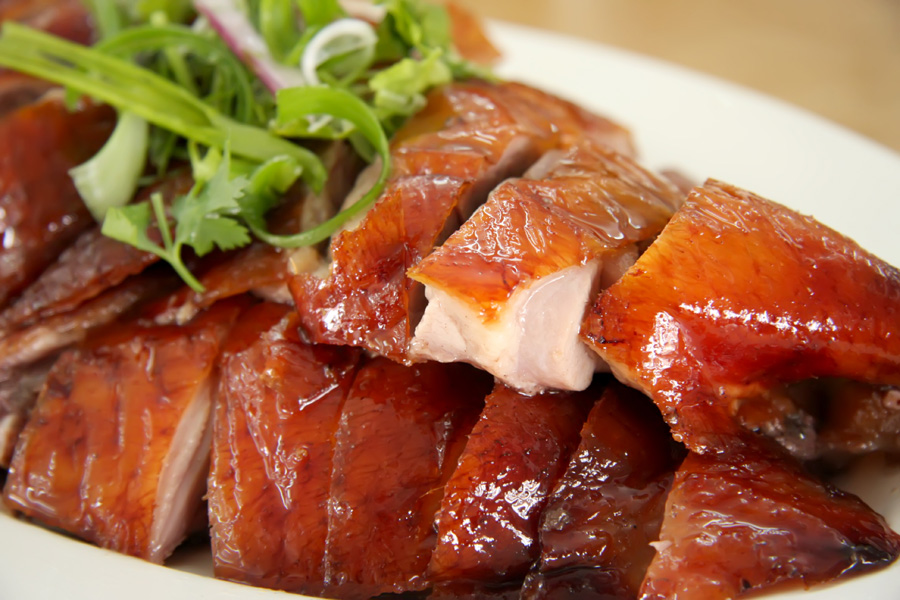[fshow photosetid=72157667131401162]
Hong Kong is a foodie’s paradise. In this city that never sleeps it is possible to order pizza at 3 am or tuck into a steaming hot bowl of noodles for breakfast. In addition to a long and proud culinary history, Hong Kong is also a melting pot of people from all corners of the world who bring their own food into the mix. Here is a guide on what to eat in Hong Kong – and when.
Breakfast
Hong Kong is full of mum-and-pop shops serving simple breakfast staples like soft, white toast with eggs, ham and sausages. If this is too close to your typical American breakfast favourites or the British fry-up, go for something decidedly more local – the pineapple bun for example, which, despite its name, doesn’t contain pineapple but rather a copious amount of sugar, which allows the crust to become crispy and the inside to develop into a sweet, refined universe of cloud-like texture. As if that in itself wasn’t sinful enough, pineapple buns are usually enjoyed with butter or custard cream. A good place to try pineapple is Kam Wah Cafe on 47 Bute Street, Mongkok.
Another breakfast staple in Hong Kong is congee, a thick rice porridge that is sure to fill you up way past noon. Commonly served with pork meatballs or pieces of fish, congee in itself is pretty plain but condiments include chives, white pepper, fresh ginger, fried shallots and deep-fried dough. Adding an egg and allowing the piping hot congee to slightly cook it also doesn’t hurt. The jury is still out on the best congee shop in Hong Kong but for an authentic Cantonese style congee, try out Wong Chi Kee in the basement of 10-12 Stanley Street, Central.
Morning Snack
The Asian propensity for snacking means that you won’t have to walk far for a bite to eat, whether you’re craving something sweet or savoury. For something in between, you should try bak kwa, a salty-sweet dried meat product, that originated in Fuijan province and spread throughout China and places with many Chinese immigrants. Bak kwa is traditionally made with pork although versions with beef and mutton also exist. The meat is marinated in spices, sugar and soy sauce before being dried and sometimes grilled. Although Bee Cheng Hiang originated in Singapore, its dried meat products have become popular throughout Asia and the Hong Kong store in Langham Place, Mongkok, is worth a visit.
Lunch
Perhaps the most famous Hong Kong lunch consists of dim sum, an array of steamed, fried and baked dumplings with various fillings. While what actually categorises as dim sum is anyone’s guess, there are a few items that you will find in any dim sum restaurant. These include har gow (steamed shrimp dumplings), shao mai (steamed pork or shrimp dumplings, usually with a topping of crab roe), char siu bao (steamed bun with a barbecued pork filling) and of course egg tarts. Other popular items include small barbecued pork ribs, turnip cakes, and steamed buns with a filling of salty egg yolk custard. There is no such thing as the best dim sum restaurant in Hong Kong (there’s simply too many to choose from) but if you’re after a good local experience head to Lin Heung Kui in Sheung Wan. If you’re looking for something decidedly more refined, try Michelin-starred Yan Toh Heen at the InterContinental, Tsim Sha Tsui.
Afternoon Snack
A must try when visiting Hong Kong is the egg tart, brought to the island by Portuguese traders which came from Macau and spread via the island’s many cha chaan tengs, or tea restaurants. While the origins of the egg tart is still debated, the tarts have become widely spread and are served not only in cha chaan tengs but also bakeries, dim sum restaurants and hole-in-the-wall outlets. There are two main distinctions when it comes to egg tarts in Hong Kong; the shortbread version and the version with the lighter, flaky crust, the latter of which was popularised in the late 1980s in Macau. Honkies (an amicable term for people living in Hong Kong) are commonly fairly passionate when it comes to food, and egg tarts are no different so it is not surprising that there is no single answer as to who sells the best egg tarts. For those with a preference for the shortbread pastry, Tai Cheong Bakery is a good place to start (various outlets, including Lyndhurst Terrace, Central), while those who prefer flaky pastry should head for Lord Stow’s Bakery, the chain which originally opened in Macau (G/F The Excelsior Hong Kong, Causeway Bay).
Dinner
Cantonese food is known for its delicious seafood and if you’re a lover of everything from the sea, you should definitely take advantage of the huge variety of seafood on offer here. Jumbo and Tai Pak are two of Hong Kong’s most famous seafood restaurants. Located on two huge floaters next to each other in Aberdeen harbour, they are owned by the same company and cater to both tourists and locals with their huge menus and rather busy atmosphere. For something a little quieter (but only just), try Ah Shun’s Kitchen on 47 Tan San Street, Cheung Chau.
Tips
Eating in a different culture oftentimes comes with its share of potential faux pas and here are some of the things you should consider in Hong Kong.
- Communal dining is a common concept, so don’t be surprised if you’re led to share a table with strangers. It’s normal.
- In Chinese restaurants, a member of staff will sometimes offer you a tissue or place a side dish on your table without you ordering it. These are rarely gestures of hospitality, rather they come at an extra cost, so just be aware.
- In busy restaurants, don’t linger over your food. You are expected to do what you came for (eat) and then leave so others can get your space.

